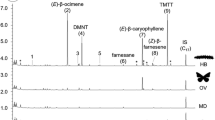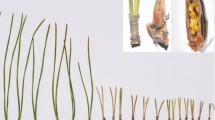Abstract
The effect of needle damage on the release rate of Masson pine (Pinus massoniana Lamb.) volatiles was examined. Needles were continuously damaged by mechanical damage (MDP) or by feeding of pine caterpillar (Dendrolimus punctatus) larvae (LFP); undamaged pine was used as a control (UDP). Volatiles were collected before damage, and at 16, 24, 40, 48, 64, 72, 88 and 96 h post-damage, and analyzed. The analyses revealed that 19 compounds identified as constitutive volatiles from UDP were terpenes and green leaf odors. The release rate of volatiles from MDP or LFP was higher than that from UDP. At 96 h post-damage, emission from MDP or LFP returned to the same level as that of UDP. Some volatiles, including sabinene, ocimene, limonene-1,2-epoxide, linalool, linalool acetate, germacrene d-4-ol, farnesol, and (E)-4,8-dimethyl-1,3,7-nonatriene were induced by mechanical damage and/or larval attack. Furthermore, the release rate of linalool acetate, farnesol, or (E)-4,8-dimethyl-1,3,7-nonatriene from LFP was higher than that from MDP. Based on an exact estimation of the proportion of damaged pine needles, a significant linear correlation between the release rate of total volatiles identified and the proportion of damaged needles was found in the case of LFP but not MDP.




Similar content being viewed by others

References
Alborn HT, Turlings TCJ, Jones TH, Stenhagen G, Loughrin JH, Tumlinson JH (1997) An elicitor of plant volatiles from beet armyworm oral secretion. Science 267:945–949
Dao XT (1990) Outbreaks of the pine defoliator (Dendrolimus punctatus Walker) in pine plantations in Vietnam. In: FAO, Regional Office for Asia and the Pacific (RAPA) (ed) Pests and diseases of forest plantations in the Asia-Pacific Region. Bangkok, Thailand, pp 187–190
De Moraes CM, Lewis WJ, Pare PW, Alborn HT, Tumlinson JH (1998) Herbivore-infested plants selectively attract parasitoids. Nature 393:570–573
Dicke M, Sabelis MW, Takabayashi J, Bruin J, Posthumus MA (1990) Plant strategies of manipulating predator-prey interactions through allelochemicals: prospects for application in pest control. J Chem Ecol 16:3091–3118
Hao Q, Ha CY (2000) Analysis of essential oil components from leaves of Pinus massoniana by gas chromatography/mass spectrometry. Chin J Anal Chem 28:300–302
Hou TQ (1987) Pine caterpillar in China. Science Press, Beijing, pp 6–31
Hu ZH, Yang D, Shen YB (2004) Difference in volatiles of poplar induced by various damages. J For Res 15:280–282
Huang LL, Liu XP, Han RD, Wang GH, Sun JH, Ge F (2006) The effect of damaged and non-damaged pine needle on the tropism selection of parasitoid Trichogramma dendrolimi. Chin Bull Entomol 43:215–219
Kessler A, Baldwin IT (2001) Defensive function of herbivore-induced plant volatile emissions in nature. Science 291:2141–2144
Lewinsohn E, Gijzen M, Croteay R (1991) Defense mechanisms of conifers: differences in constitutive and wound-induced monoterpene synthesis among species. Plant Physiol 96:44–49
Litvak ME, Monson RK (1998) Patterns of induced and constitutive monoterpenes production in conifer needles in relation to insect herbivory. Oecologia 114:531–540
Loreto F, Ciccioli P, Cecinato A, Brancaleoni E, Frattoni M, Sharkey TD (1996) Different sources of acetyl CoA contribute to form three classes of terpenoid emitted by Quercus ilex L. leaves. Proc Natl Acad Sci USA 93:9966–9969
Loreto F, Nascetti P, Graverini A, Mannozzi M (2000) Emission and content of monoterpenes in intact and wounded needles of the Mediterranean Pine, Pinus pinea. Funct Ecol 14:589–595
Loughrin JH, Manukian A, Heath RR, Turlings TCJ, Tumlinson JH (1994) Diurnal cycle of emission of induced volatile terpenoids by herbivore-injured cotton plants. Proc Natl Acad Sci USA 91:11836–11840
Loughrin JH, Manukian A, Heath RR, Tumlinson JH (1995) Volatile emitted by different cotton varieties damaged by feeding beet armyworm larvae. J Chem Ecol 21:1217–1227
Mattiacci L, Dicke M, Posthumus MA (1995) β-Glucosidase: an elicitor of herbivore-induced plant odor that attracts host-searching parasitic wasps. Proc Natl Acad Sci USA 92:2036–2040
Mithöfer A, Wanner G, Boland W (2005) Effects of feeding Spodoptera littoralis on lima bean leaves. II. Continuous mechanical wounding resembling insect feeding is sufficient to elicit herbivory-related volatile emission. Plant Physiol 137:1160–1168
McCall PJ, Turlings TCJ, Lewis WJ, Tumlinson JH (1993) Role of plant volatiles in host location by the specialist parasitoid Microplitis croceipes Cresson (Braconidae: Hymenoptera). J Insect Behav 6:625–639
Michelozzi M (1999) Defensive roles of terpenoid mixtures in conifers. Acta Bot Gallica 146:73–84
Qin XW, Su JW, Ge F, Zhou ZQ (2006) Enantiomeric composition and relative abundance of monoterpene hydrocarbon in volatiles of Pinus massoniana Lamb., Pinus tabulaeformis Cai, and Pinus elliottii Engelm. J Instr Anal 25:6–9
Ren Q, Li ZY, Hu YJ, Jin YJ, Chen HJ (2005) Volatile compounds release from damaged Pinus massonion and Pinus elliotii. Acta Ecol Sin 25:2928–2932
Röse USR, Manukian A, Heath RR, Tumlinson JH (1996) Volatile semiochemicals released from undamaged cotton leaves. Plant Physiol 111:487–495
Schürmann W, Ziegler H, Kotzias D, Schonwitz R, Steinbrecher R (1993) Emission of biosynthesized monoterpenes from needles of Norway spruce. Naturwissenschaften 80:276–278
Shen CM, Duan WG, Cen B, Tan JH (2006) Comparison of chemical components of essential oils in needles of Pinus massoniana Lamb and Pinus elliottii Engelm from Guangxi. Se Pu 24(6):619–624
Staudt M, Bertin N, Hansen U, Seufert G, Ciccioli P, Foster P, Frenzel B, Fugit JL (1997) Seasonal and diurnal patterns of monoterpenes emissions from Pinus pinea (L.). Atmos Environ 31:145–156
Su JW, Gao F, Liu L, Ge F (2007) Components and emitting rate of volatiles released from transgenic cotton damaged by cotton bollworm. Plant Prot 33:29–33
Takabashi J, Dicke M, Posthumus MA (1991) Induction of indirect defense against spider mites in uninfested lima bean leaves. Phytochemistry 30:1459–1462
Turlings TCJ, Tumlinson JH, Lewis WJ (1990) Exploitation of herbivore-induced plant odors by host-seeking parasitic wasps. Science 250:1251–1253
Zagatti P, Lempérière G, Malosse C (1997) Monoterpenes emitted by the large pine weevil, Hylobius abietis (L.) feeding on Scots pine, Pinus sylvestris L. Physiol Entomol 22:394–400
Zhang GM, Fang WZ, Wang XH, Kang WT, Lin ZW, Luo DM (2002) Compositions and seasonal pattern of essential oils in Pinus massoniana L. needles from Xiamen. J Xiamen Univ (Nat Sci) 41:584–588
Zhao CH, Yan YH (2003) Oviposition behaviour of the pine caterpillar moth, Dendrolimus punctatus influenced by needle volatiles of Pinus massoniana. Sci Silv Sin 39:91–93
Zhao CH, Wu DM, Yan YH, Li Q (1995) Analysis of masson pine needles volatiles and their electroantennogram activity with masson pine caterpillar. Sci Silv Sin 31:125–131
Acknowledgments
We would like to thank our associates Mr. Zhong He, Dr. Feng Gao and Dr. X.J. Song for their invaluable help with the experiment, and Prof. Chenghua Zhao and Xianzuo Meng for their authentic reference compounds. We thank Prof. Jeffrey E. Slosser (Texas A & M University, USA) for assistance with the English version. This study was supported by the National Natural Science Foundation of China (30330490).
Author information
Authors and Affiliations
Corresponding author
Rights and permissions
About this article
Cite this article
Su, JW., Zeng, JP., Qin, XW. et al. Effect of needle damage on the release rate of Masson pine (Pinus massoniana) volatiles. J Plant Res 122, 193–200 (2009). https://doi.org/10.1007/s10265-008-0203-7
Received:
Accepted:
Published:
Issue Date:
DOI: https://doi.org/10.1007/s10265-008-0203-7



